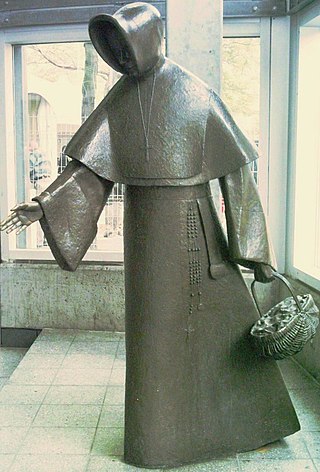Notes
Related Research Articles

A nun is a woman who vows to dedicate her life to religious service and contemplation, typically living under vows of poverty, chastity, and obedience in the enclosure of a monastery or convent. The term is often used interchangeably with religious sisters who do take simple vows but live an active vocation of prayer and charitable work.

The Missionaries of Charity is a Catholic centralised religious institute of consecrated life of Pontifical Right for women established in 1950 by Mother Teresa, now known in the Catholic Church as Saint Teresa of Calcutta. As of 2023, it consisted of 5,750 members of religious sisters. Members of the order designate their affiliation using the order's initials, "M.C.". A member of the congregation must adhere to the vows of chastity, poverty, obedience, and the fourth vow, to give "wholehearted free service to the poorest of the poor." Today, the order consists of both contemplative and active branches in several countries.
The Institute of the Blessed Virgin Mary, whose members are commonly known as the Loreto Sisters, is a Roman Catholic religious congregation of women dedicated to education founded in Saint-Omer by an Englishwoman, Mary Ward, in 1609. The congregation takes its name from the Marian shrine at Loreto in Italy where Ward used to pray. Ward was declared Venerable by Pope Benedict XVI on 19 December 2009. The Loreto Sisters use the initials I.B.V.M. after their names.
A provincial superior is an officer of a religious institute acting under the institute's Superior General. A provincial superior exercises general supervision over all the members of that institute in a territorial division of the order called a province, which is similar to, but not to be confused with, an ecclesiastical province. Instead, the province under a provincial superior is one made up of particular churches or dioceses under the supervision of a Metropolitan Bishop. The division of a religious institute into provinces is generally along geographical lines and may consist of one or more countries, or of only a part of a country. There may be, however, one or more houses of one province situated within the physical territory of another since the jurisdiction over the individual religious is personal, rather than territorial. The title of the office is often abbreviated to Provincial.
A canoness is a member of a religious community of women, historically a stable community dedicated to the celebration of the Liturgy of the Hours in a particular church. The name corresponds to a canon, the male equivalent, and both roles share a common historical origin. As with the canons, there are two types: canonesses regular, who follow the Rule of St Augustine, and secular canonesses, who follow no monastic rule of life.

The Sisters of Charity of Nazareth (SCN) is a Roman Catholic order of religious sisters. It was founded in 1812 near Bardstown, Kentucky, when three young women responded to Bishop John Baptist Mary David's call for assistance in ministering to the needs of the people of the area.

The Sisters of Providence are a religious institute of Roman Catholic sisters founded in 1843 by Émilie Gamelin. They are headquartered in Montreal, Quebec with five provinces: Mother Joseph Province, Holy Angels Province, Philippines Vice-Province, Émilie-Gamelin Province and Bernard Morin Province.
A religious congregation is a type of religious institute in the Catholic Church. They are legally distinguished from religious orders – the other major type of religious institute – in that members take simple vows, whereas members of religious orders take solemn vows.
The Sisters of St. Joseph of Carondelet (CSJ) are a Roman Catholic congregation of women religious which traces its origins to a group founded in Le Puy-en-Velay, France around 1650 by Jean Pierre Medaille, S.J. The design of the congregation was based on the spirituality of the Society of Jesus. The Sisters of St. Joseph of Carondelet became a separate congregation of pontifical right on May 16, 1877.
Prior is an ecclesiastical title for a superior in some religious orders. The word is derived from the Latin for "earlier" or "first". Its earlier generic usage referred to any monastic superior. In abbeys, a prior would be lower in rank than the abbey's abbot or abbess.
In the Catholic Church, a canonical visitation is the act of an ecclesiastical superior who in the discharge of his office visits persons or places with a view to maintaining faith and discipline and of correcting abuses. A person delegated to carry out such a visitation is called a visitor. When, in exceptional circumstances, the Holy See delegates an apostolic visitor "to evaluate an ecclesiastical institute such as a seminary, diocese, or religious institute [...] to assist the institute in question to improve the way in which it carries out its function in the life of the Church," this is known as an apostolic visitation.
The Third Order of Saint Francis is a third order in the Franciscan tradition of Christianity, founded by the medieval Italian Catholic friar Francis of Assisi.

Marguerite d'Youville, SGM was a French Canadian widow who founded the Sisters of Charity of Montreal, commonly known as the "Grey Nuns". She was canonized by Pope John Paul II in 1990, becoming the first native-born Canadian to be declared a saint.
The Missionaries of St. Francis de Sales (MSFS), also known as the Fransalians, was founded in Annecy, France on 24 October 1838 by Peter Mermier under the patronage of Francis de Sales. Mermier felt that the political disturbances of the French Revolution had left the French people in spiritual crisis, and took up preaching parish missions in the hope of bringing about spiritual renewal. This special apostolate in turn gave rise to a community of preachers gathered around Mermier.

The Order of Our Lady of Charity is a Roman Catholic monastic order, founded in 1641 by Catholic saint, John Eudes in Caen, France.

The Council of Major Superiors of Women Religious (CMSWR) is one of two associations of the leaders of congregations of Catholic women religious in the United States. As of December 2020, CMSWR includes the leaders of 112 religious congregations which have a total membership of approximately 5,700 women religious in the United States.

The Congregation of the Sisters of Charity of Jesus and Mary is a Roman Catholic religious institute founded in Ghent, Belgium. An enclosed religious order, its main apostolate is helping the needy and the sick, inspired by the work of Saint Vincent de Paul and Saint Bernard of Clairvaux.
The Missionary Sisters of the Sacred Heart of Jesus is a Catholic female religious congregation founded in 1880 by Frances Xavier Cabrini. Their aim is to spread devotion to the Sacred Heart by means of spiritual and corporal works of mercy.

Women play significant roles in the life of the Catholic Church, although excluded from the Catholic hierarchy of bishops, priests, and deacons. In the history of the Catholic Church, the church often influenced social attitudes toward women. Influential Catholic women have included theologians, abbesses, monarchs, missionaries, mystics, martyrs, scientists, nurses, hospital administrators, educationalists, religious sisters, Doctors of the Church, and canonised saints. Women constitute the majority of members of consecrated life in the Catholic Church: in 2010, there were around 721,935 professed women religious. Motherhood and family are given an exalted status in Catholicism, with The Blessed Virgin Mary holding a special place of veneration.

A religious sister in the Catholic Church is a woman who has taken public vows in a religious institute dedicated to apostolic works, as distinguished from a nun who lives a cloistered monastic life dedicated to prayer and labor, or a canoness regular, who provides a service to the world, either teaching or nursing, within the confines of the monastery. Nuns, religious sisters and canonesses all use the term "Sister" as a form of address.
References
- 1 2 Sacred Congregation for Religious and for Secular Institutes (31 May 1983). "Section II: Characteristics; 9: Government". Magisterium on Religious Life, 1983. Vatican. p. 51. Retrieved 16 November 2021.
- ↑ Vermeersch (1911a).
- ↑ IANS: HT Correspondent (26 March 2009). "Sister Prema is new head of Missionaries of Charity". Hindustan Times. Retrieved 16 November 2021.
{{cite news}}:|last1=has generic name (help) - ↑ Cooper, Kenneth J (15 September 1997). "Mother Teresa, 1910 - 1997". The Washington Post. www.washingtonpost.com. p. A16.
Seven years ago, Mother Teresa tried hard to step down as superior general of her Missionaries of Charity, obtaining the Vatican's permission to retire ...
- ↑ Vermeersch (1911b).
Sources
 This article incorporates text from a publication now in the public domain : Vermeersch, Arthur (1911a). "Nuns". In Herbermann, Charles (ed.). Catholic Encyclopedia . Vol. 11. New York: Robert Appleton Company.
This article incorporates text from a publication now in the public domain : Vermeersch, Arthur (1911a). "Nuns". In Herbermann, Charles (ed.). Catholic Encyclopedia . Vol. 11. New York: Robert Appleton Company. This article incorporates text from a publication now in the public domain : Vermeersch, Arthur (1911b). "Provincial". In Herbermann, Charles (ed.). Catholic Encyclopedia . Vol. 12. New York: Robert Appleton Company.
This article incorporates text from a publication now in the public domain : Vermeersch, Arthur (1911b). "Provincial". In Herbermann, Charles (ed.). Catholic Encyclopedia . Vol. 12. New York: Robert Appleton Company.
